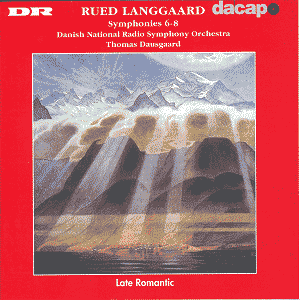Rued LANGGAARD (1893-1952)
Symphony No. 6 Det Himmelrivende (1920 rev 1930)
Symphony No. 7 (1926 version)
Symphony No. 8 Minder ved Amalienborg (1928 rev
1934)
 Danish National RSO/Thomas
Dausgaard
Danish National RSO/Thomas
Dausgaard
rec Aug 1998-Aug 2000, Danish Radio House.
DDD
 DACAPO 8.224180
[56.58]
DACAPO 8.224180
[56.58]
Crotchet AmazonUK
AmazonUS
Amazon
recommendations

Yes, that's right. Three symphonies in just less than 57 minutes. Such is
the product of that wayward and never boring eccentric, Rued Langgaard.
The Sixth Symphony represents a combination of the type of Franckian
luxuriance to be found in Psyché, a peaceable Finzian 'kingdom'
as in the Thema Version 1, the orientally challenging Turandot
and the swerving unpredictability of a Tippett-like fugue (Variation
II). It is no wonder that Calum Macdonald in his still extremely readable
book 'Opus Est' (Kahn & Averill, 1979) placed him alongside such 'outsiders'
as Havergal Brian whose own 20 minute symphonies have something of the same
feeling though denser in expression. Nielsen's influence can be discerned
in the Sonata movement. The Danish title is variously translated as 'Heavens
Asunder' and 'The Heaven Storming'.
The Sixth Symphony plays for 21.41 in this version as against Frandsen's
20.51 (Danacord DACOCD 560), Stupel's 20.54 (Danacord DACOCD 406) and
Järvi's 20.12 (Chandos CHAN 9064).
Järvi is fleeter and does not have the poise of the Dausgaard. The Nielsen
echoes seem even more substantial in Järvi's hands. The sound on the
Chandos is a shade superior though there is little between the four versions
so far as audio quality is concerned. Stupel's recording bands the symphony
in one segment as does Danacord's ADD Frandsen from 1977. Little to choose
between them really if you can live with the light speckle of coughs from
the Danish audience in the Frandsen specifically in the great Thema I.
The Seventh has the air of a Beethoven symphony (perhaps No. 4) cross-bred
with Nielsen's First Symphony, Mendelssohn's Ruy Blas, Schumann's
Rhenish and Mozart's Prague Symphony. That should have you
scratching your head! The only comparison is not a direct one and that is
with its own later version as rather beautifully recorded by Ilya Stupel
for Danacord (DACOCD 407) in Lodz in 1991. The brass of the Artur Rubinstein
Philharmonic sound rather hesitant by comparison with Dausggaard's orchestra.
Stupel takes the score at a dancing lick. The Symphony is only 16.25 (18.19
in the 1932 Stupel version) and is far less controversial and 'modern' than
its predecessor from 1920 - at least until we get to the macabre play of
the Scherzoso.
Symphony No. 8 (Memories at Amalienborg) is another compact
piece - playing for 18.48 under Dausggaard and 16.42 under Stupel (DACOCD
409). The piano plays a prominent concertante part in the first movement
but this is no piano concerto. Beethoven and Schumann had clearly imprinted
themselves on Langgaard's creative 'forge' by the time he came to write and
revise this symphony. As the Danacord notes comment, the symphony is problematic
and fewer eyebrows would have been raised if he had hedged his bets and termed
it a 'suite' as he did with the Fourteenth Symphony Morning. Call
it what you will, this is pleasant stuff. Symphonic fibre? Not really ..
and that Finale is quite repetitive.
There is no direct competition for this disc - no identical coupling and
the Seventh Symphony is recorded in a version never previously committed
to commercial disc.
Langgaard collectors must have this for the premiere recording of the original
version of the Seventh Symphony. Overall this collection satisfies for an
extremely fine version of the Sixth Symphony - the best so far. However for
a Langgaard neophyte there is no better introduction that Danacord's 2CD
reissue (Danacord DACOCD 560) of symphonies 4, 6, 14 and 15 with his masterpiece
Sfaerernes Music.
If the delightful Blake-ian watercolour(?) by J F Willumsen 'Sol over sydens
Bjerge' (1902) is anything to go by the world has just as much to learn about
Danish pictorial art as it has about Danish music. The picture is suggestive
of Det Himmelrivende.
Rob Barnett

